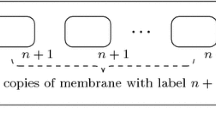Abstract
We consider synchronized membrane systems extended with communication and division rules, using the maximal parallelism evolution strategy together with synchronization between non-cooperating rewriting rules of length at most three. We prove that in this framework, we can obtain in polynomial time solutions to the NP-complete problems SAT, Threshold-SAT and Unique-SAT.
Similar content being viewed by others
References
Alhazov, A., Margenstern, M., & Verlan, S. (2008). Fast synchronization in P systems. In: D.W. Corne, P. Frisco, G. Păun, G. Rozenberg, A. Salomaa (Eds.) Membrane computing—9th international workshop, WMC 2008, Edinburgh, UK, July 28–31, 2008, revised selected and invited papers, lecture notes in computer science (vol. 5391, pp. 118–128). Springer. https://doi.org/10.1007/978-3-540-95885-7_9
Alhazov, A., Pan, L., & Păun, G. (2004). Trading polarizations for labels in P systems with active membranes. Acta Informatica, 41(2–3), 111–144. https://doi.org/10.1007/s00236-004-0153-z
Aman, B., & Ciobanu, G. (2008). Describing the immune system using enhanced mobile membranes. Electronic Notes in Theoretical Computer Science, 194(3), 5–18. https://doi.org/10.1016/j.entcs.2007.12.003.
Aman, B., & Ciobanu, G. (2009). Turing completeness using three mobile membranes. In: C.S. Calude, J.F. Costa, N. Dershowitz, E. Freire, G. Rozenberg (Eds.) Unconventional computation, 8th international conference, UC 2009, Ponta Delgada, Azores, Portugal, September 7–11, 2009. Proceedings, Lecture Notes in Computer Science (vol. 5715, pp. 42–55). Springer. https://doi.org/10.1007/978-3-642-03745-0_12
Aman, B., & Ciobanu, G. (2011). Mobility in process calculi and natural computing. Natural computing series. Berlin: Springer. https://doi.org/10.1007/978-3-642-24867-2.
Aman, B., & Ciobanu, G. (2011). Solving a weak NP-complete problem in polynomial time by using mutual mobile membrane systems. Acta Informatica, 48(7–8), 409–415. https://doi.org/10.1007/s00236-011-0144-9
Aman, B., & Ciobanu, G. (2017). Efficiently solving the bin packing problem through bio-inspired mobility. Acta Informatica, 54(4), 435–445. https://doi.org/10.1007/s00236-016-0264-3
Aman, B., & Ciobanu, G. (2018). Adaptive P systems. In: T. Hinze, G. Rozenberg, A. Salomaa, C. Zandron (Eds.) Membrane computing—19th international conference, CMC 2018, Dresden, Germany, September 4–7, 2018, revised selected papers, lecture notes in computer science (vol. 11399, pp. 57–72). Springer. https://doi.org/10.1007/978-3-030-12797-8_5
Aman, B., & Ciobanu, G. (2019). Synchronization of rules in membrane computing. Journal of Membrane Computing, 1(4), 233–240. https://doi.org/10.1007/s41965-019-00022-1.
Cavaliere, M., & Sburlan, D. (2005). Time and synchronization in membrane systems. Fundamenta Informaticae, 64(1-4), 65–77. http://www.content.iospress.com/articles/fundamenta-informaticae/fi64-1-4-07
Cecilia, J. M., García, J. M., Guerrero, G. D., Martínez-del-Amor, M. A., Pérez-Hurtado, I., & Pérez-Jiménez, M. J. (2010). Simulating a P system based efficient solution to SAT by using GPUs. Journal of Logical and Algebraic Methods in Programming, 79(6), 317–325. https://doi.org/10.1016/j.jlap.2010.03.008.
Ciobanu, G., Pérez-Jiménez, M. J., & Păun, G. (Eds.). (2006). Applications of membrane computing. Natural computing series. Berlin: Springer. https://doi.org/10.1007/3-540-29937-8.
Dinneen, M. J., Kim, Y., & Nicolescu, R. (2012). Faster synchronization in P systems. Natural Computing, 11(1), 107–115. https://doi.org/10.1007/s11047-011-9271-z.
Frisco, P., Gheorghe, M., & Pérez-Jiménez, M. J. (Eds.). (2014). Applications of membrane computing in systems and synthetic biology. Emergence, complexity and computation. Berlin: Springer. https://doi.org/10.1007/978-3-319-03191-0.
Garey, M. R., & Johnson, D. S. (1979). Computers and intractability: A guide to the theory of NP-completeness. New York: W. H. Freeman.
Gheorghe, M., & Ipate, F. (2013). A kernel P systems survey. In A. Alhazov, S. Cojocaru, M. Gheorghe, Y. Rogozhin, G. Rozenberg, A. Salomaa (Eds.) Membrane computing—14th international conference, CMC 2013, Chişinău, Republic of Moldova, August 20–23, 2013, revised selected papers, lecture notes in computer science (vol. 8340, pp. 1–9). Springer. https://doi.org/10.1007/978-3-642-54239-8_1
Gutiérrez-Naranjo, M. A., Pérez-Jiménez, M. J., & Romero-Campero, F. J. (2007). A uniform solution to SAT using membrane creation. Theoretical Computer Science, 371(1–2), 54–61. https://doi.org/10.1016/j.tcs.2006.10.013.
Orellana-Martín, D., Valencia-Cabrera, L., Riscos-Núñez, A., & Pérez-Jiménez, M. (2018). The unique satisfiability problem from a membrane computing perspective. Romanian Journal of Information Science and Technology, 21, 288–297.
Pan, L., & Alhazov, A. (2006). Solving HPP and SAT by P systems with active membranes and separation rules. Acta Informatica, 43(2), 131–145. https://doi.org/10.1007/s00236-006-0018-8
Păun, G. (2001). P systems with active membranes: Attacking NP-complete problems. Journal of Automata, Languages and Combinatorics, 6(1), 75–90. https://doi.org/10.25596/jalc-2001-075.
Păun, G. (2002). Membrane computing: An introduction. Natural computing series. Berlin: Springer. https://doi.org/10.1007/978-3-642-56196-2.
Păun, G., Rozenberg, G., & Salomaa, A. (2010). The Oxford handbook of membrane computing. Oxford: Oxford University Press Inc.
Păun, G., & Yu, S. (1999). On synchronization in P systems. Fundamenta Informaticae, 38(4), 397–410. https://doi.org/10.3233/FI-1999-38404.
Pérez-Jiménez, M.J. (2004). An approach to computational complexity in membrane computing. In G. Mauri, G. Paun, M.J. Pérez-Jiménez, G. Rozenberg, A. Salomaa (Eds.) Membrane computing, 5th international workshop, WMC 2004, Milan, Italy, June 14–16, 2004, revised selected and invited papers, lecture notes in computer science (vol. 3365, pp. 85–109). Springer. https://doi.org/10.1007/978-3-540-31837-8_5.
Pérez-Jiménez, M. J., Jiménez, Á. R., & Sancho-Caparrini, F. (2003). Complexity classes in models of cellular computing with membranes. Natural Computing, 2(3), 265–285. https://doi.org/10.1023/A:1025449224520.
Pérez-Jiménez, M. J., Riscos-Núñez, A., Romero-Jiménez, Á., & Woods, D. (2010). Complexity: Membrane division, membrane creation. In G. Păun, G. Rozenberg, & A. Salomaa (Eds.), The Oxford handbook of membrane computing (pp. 302–336). Oxford: Oxford University Press Inc.
Porreca, A. E., Leporati, A., Mauri, G., & Zandron, C. (2011). Elementary active membranes have the power of counting. International Journal of Natural Computing Research, 2(3), 35–48. https://doi.org/10.4018/jncr.2011070104.
Rozenberg, G., & Salomaa, A. (Eds.). (1997). Handbook of formal languages (Vol. 3). Berlin: Springer.
Song, B., & Pan, L. (2021). Rule synchronization for tissue P systems. Information and Computation. https://doi.org/10.1016/j.ic.2020.104685.
Zhang, G., Pérez-Jiménez, M. J., & Gheorghe, M. (Eds.). (2017). Real-life applications with membrane computing. Emergence, complexity and computation. Berlin: Springer. https://doi.org/10.1007/978-3-319-55989-6.
Author information
Authors and Affiliations
Corresponding author
Ethics declarations
Conflict of interest
The author declares he has no financial interests and no conflicts of interest.
Additional information
Publisher's Note
Springer Nature remains neutral with regard to jurisdictional claims in published maps and institutional affiliations.
This work was presented at the Int’l Conference on Membrane Computing (ICMC21).
Rights and permissions
About this article
Cite this article
Aman, B. On the efficiency of synchronized P systems. J Membr Comput 4, 1–10 (2022). https://doi.org/10.1007/s41965-021-00091-1
Received:
Accepted:
Published:
Issue Date:
DOI: https://doi.org/10.1007/s41965-021-00091-1




